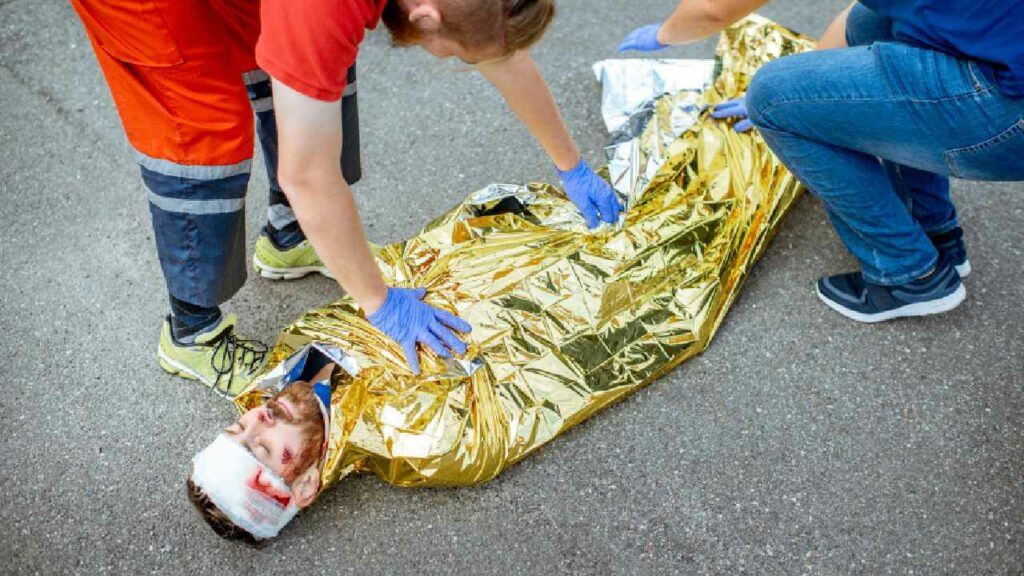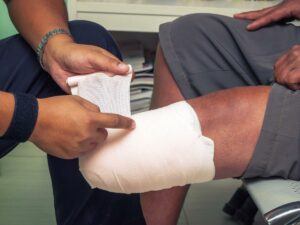Shock can often take people by surprise. Unlike the injury or event that causes shock, its symptoms often appear gradually over time, and can turn an apparently minor injury into a life-threatening one.
While you may know how to apply first aid to the injuries that cause shock, making sure you can treat the shock itself is a vital skill. Read on to learn first aid for shock.
Here’s a summary of what you’ll find below:
- What is Shock?
- Is Shock Life-Threatening?
- Symptoms of Shock
- How to Provide First Aid for Shock
- Feel Confident with First Aid Training
What is Shock?
There are two main things you need to know about shock.
First, when referred to in a medical context, it isn’t an emotional condition. If you see something that is shocking, and react emotionally, that isn’t the same as going into shock, which is suffering from a physical condition called shock.
Second, shock isn’t a condition that appears on its own. It is a response to a causal event, such as:
- Trauma
- An allergic reaction
- An animal bite
- Burns
- Infection
- Heatstroke
When these injuries occur, they can trigger a defence mechanism in your body. Fearing blood loss, your body will constrict its blood vessels to drop your blood pressure. This conserves it for your vital organs, which need blood flow to receive the oxygen that keeps them functioning – and keeps you alive.
If you are actually suffering from extreme blood loss, constriction can be helpful. The problem is, your body can overreact and go into shock even when an injury isn’t life-threatening.
The problem is, the initial injury often occupies the first aid responder’s attention. Then, after it is treated, a person can develop associated shock symptoms without anyone realising until it becomes serious.
Is Shock Life-Threatening?
Shock can be life-threatening, and can also cause far more severe damage to a person than the initial injury that caused it.
The problem with dropping blood pressure is that in order to protect the heart and brain, the body will starve less vital organs of blood and oxygen.
If enough time passes, organs can fail or suffer irreparable damage, and eventually multiple organ failure can lead to death. That’s why understanding how to apply first aid to shock patients needs to be a critical part of your first aid skill set.
Symptoms of Shock
Symptoms of shock can appear gradually over time, and don’t always appear sequentially. It also isn’t uncommon for some symptoms to appear while others don’t appear at all.
The symptoms of shock are as follows:
- Blue lips and fingernails
- Cold, clammy skin with a pale colour
- Enlarged pupils
- Weakness or fatigue
- Nausea or vomiting
- Dizziness, fainting, or difficulty walking
- Rapid breathing
- Rapid pulse
- Changes in behaviour or temperament, such as anxiousness or agitation
- Unconsciousness
- Lack of vital signs
If any of these symptoms occur, you should take measures to provide first aid for shock and call an ambulance.
How to Provide First Aid for Shock
Treating shock has two components, treating the precursor injury, and then treating the shock itself.
1. Call an Ambulance
The thing you should do if you believe someone is in life-threatening danger is call an ambulance. It’s better to call one and have it not be needed, than not call one and risk a preventable death.
2. Lay the Person Down
Once you’ve called an ambulance, your first priority should be laying the person suffering from shock down. Make sure they are on their back, unless they are vomiting. In that case, turn them on their side.
Once they are laying down and are comfortable, try to elevate their legs so that they are above their heart. This will encourage blood flow back towards the torso. Obviously, if their legs or hips are injured, don’t complete this step.
3. Follow the DRSABCD Steps
DRSABCD is a CPR method that takes you through the steps required to check a person’s vitals and attempt to resuscitate them. If a person isn’t breathing, or has no pulse, CPR needs to take priority over any other treatment concerns.
4. Treat Initial Injuries
If you are satisfied that the shock sufferer is stable, treat the injury that is causing the shock response. While shock may continue after the injury has been treated, you can be sure that the injury isn’t prolonging the shock response.
Below you can read our guides on providing first aid for several common causes of shock.
- First aid for head injuries
- First aid for burns
- First aid for snake bites
- First aid for bee stings
- First aid for spider bites
If you aren’t able to stop blood loss with a dressing, continue to apply pressure on the wound until the ambulance arrives.
Remember, for anaphylactic shock that is caused by a bite or sting, the person may have an epipen that you can use to help them.
5. Loosen Clothing
The reason a shock patient’s blood pressure drops is because of blood vessel constriction, so you want to loosen or remove any tight clothes that could be making it difficult for blood to pump through the body.
Also consider the emotional distress of the person. When people go into shock they often panic, and the lack of oxygen in their bodies causes them to breathe more frantically. Wearing tight clothes can begin to feel claustrophobic.
6. Maintain Warmth
Blood isn’t just necessary for transporting oxygen around the body, it is also important for regulating temperature. Blood is warm, and as it travels it keeps important organs insulated.
When you get cold, you shiver. This is your body forcing you to make little movements that burn energy, which creates warmths and stimulates blood flow. The problem is, shivering depletes oxygen too, and can worsen the effects of shock.
If the person appears to be suffering from symptoms of cold or early hypothermia, make sure to cover them with something loose fitting, like a coat or a blanket. While they will likely complain about feeling cold in their extremities, like their hands and feet, you need to focus on warming their torso first.
7. Continue to Monitor Vitals and Provide Reassurance
If you’ve followed all of these first aid steps for shock, your shock patient should be stable, comfortable and warm. While they may still be suffering from shock, you have treated the causes of shock, so they should improve with time.
While you wait for the ambulance to arrive, continue to monitor their vitals, including breathing and pulse. If there are any significant changes, keep a note of them so you can tell the paramedics. If their vitals stop, commence CPR immediately.
It’s also essential that you do your best to keep the person calm. Panic responses, like erratic movement, frantic breathing and shaking all waste oxygen, so you want to limit these tendencies and keep them as still as possible.
Do Not Give Food or Drink
Do not give a shock patient food or drink. As their symptoms improve they may ask for something, but need to be firm and say no.
When the body is suffering from shock, many of its usual functions stop working properly, including eating and drinking. Any food or drink is likely to be vomited by the shock sufferer – even if they think they are feeling better.
Vomiting can lead to choking if they have a spinal injury and can’t be turned on their side. It also increases their sense of panic.
Feel Confident with First Aid Training
Shock is scary because it can happen after many common injuries, but a lot of people don’t know how to recognise it, or deal with it effectively.
If you want to learn how to provide first aid for shock, you should consider a first aid training course.
Vital First Aid provides realistic training that will keep you calm and confident about your knowledge when faced with a stressful situation, such as the onset of shock.
To find out more about our courses, visit our website. Or, if you are ready to sign up for a course and make sure you know how to deal with shock, get in touch today.






